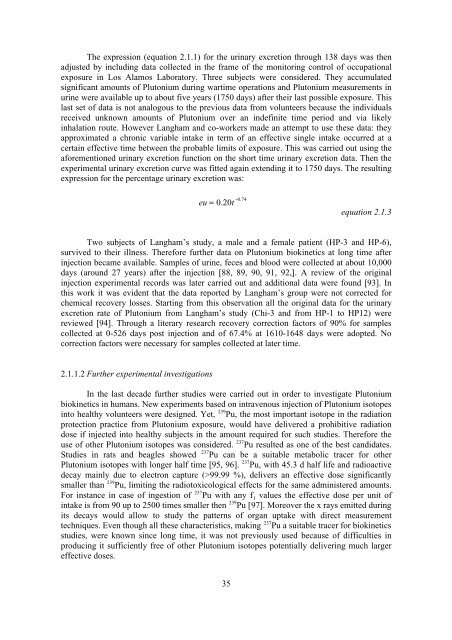Plutonium Biokinetics in Human Body A. Luciani - Kit-Bibliothek - FZK
Plutonium Biokinetics in Human Body A. Luciani - Kit-Bibliothek - FZK
Plutonium Biokinetics in Human Body A. Luciani - Kit-Bibliothek - FZK
You also want an ePaper? Increase the reach of your titles
YUMPU automatically turns print PDFs into web optimized ePapers that Google loves.
The expression (equation 2.1.1) for the ur<strong>in</strong>ary excretion through 138 days was then<br />
adjusted by <strong>in</strong>clud<strong>in</strong>g data collected <strong>in</strong> the frame of the monitor<strong>in</strong>g control of occupational<br />
exposure <strong>in</strong> Los Alamos Laboratory. Three subjects were considered. They accumulated<br />
significant amounts of <strong>Plutonium</strong> dur<strong>in</strong>g wartime operations and <strong>Plutonium</strong> measurements <strong>in</strong><br />
ur<strong>in</strong>e were available up to about five years (1750 days) after their last possible exposure. This<br />
last set of data is not analogous to the previous data from volunteers because the <strong>in</strong>dividuals<br />
received unknown amounts of <strong>Plutonium</strong> over an <strong>in</strong>def<strong>in</strong>ite time period and via likely<br />
<strong>in</strong>halation route. However Langham and co-workers made an attempt to use these data: they<br />
approximated a chronic variable <strong>in</strong>take <strong>in</strong> term of an effective s<strong>in</strong>gle <strong>in</strong>take occurred at a<br />
certa<strong>in</strong> effective time between the probable limits of exposure. This was carried out us<strong>in</strong>g the<br />
aforementioned ur<strong>in</strong>ary excretion function on the short time ur<strong>in</strong>ary excretion data. Then the<br />
experimental ur<strong>in</strong>ary excretion curve was fitted aga<strong>in</strong> extend<strong>in</strong>g it to 1750 days. The result<strong>in</strong>g<br />
expression for the percentage ur<strong>in</strong>ary excretion was:<br />
35<br />
equation 2.1.3<br />
Two subjects of Langham’s study, a male and a female patient (HP-3 and HP-6),<br />
survived to their illness. Therefore further data on <strong>Plutonium</strong> biok<strong>in</strong>etics at long time after<br />
<strong>in</strong>jection became available. Samples of ur<strong>in</strong>e, feces and blood were collected at about 10,000<br />
days (around 27 years) after the <strong>in</strong>jection [88, 89, 90, 91, 92,]. A review of the orig<strong>in</strong>al<br />
<strong>in</strong>jection experimental records was later carried out and additional data were found [93]. In<br />
this work it was evident that the data reported by Langham’s group were not corrected for<br />
chemical recovery losses. Start<strong>in</strong>g from this observation all the orig<strong>in</strong>al data for the ur<strong>in</strong>ary<br />
excretion rate of <strong>Plutonium</strong> from Langham’s study (Chi-3 and from HP-1 to HP12) were<br />
reviewed [94]. Through a literary research recovery correction factors of 90% for samples<br />
collected at 0-526 days post <strong>in</strong>jection and of 67.4% at 1610-1648 days were adopted. No<br />
correction factors were necessary for samples collected at later time.<br />
2.1.1.2 Further experimental <strong>in</strong>vestigations<br />
eu = 0.20t −0.74<br />
In the last decade further studies were carried out <strong>in</strong> order to <strong>in</strong>vestigate <strong>Plutonium</strong><br />
biok<strong>in</strong>etics <strong>in</strong> humans. New experiments based on <strong>in</strong>travenous <strong>in</strong>jection of <strong>Plutonium</strong> isotopes<br />
<strong>in</strong>to healthy volunteers were designed. Yet, 239 Pu, the most important isotope <strong>in</strong> the radiation<br />
protection practice from <strong>Plutonium</strong> exposure, would have delivered a prohibitive radiation<br />
dose if <strong>in</strong>jected <strong>in</strong>to healthy subjects <strong>in</strong> the amount required for such studies. Therefore the<br />
use of other <strong>Plutonium</strong> isotopes was considered. 237 Pu resulted as one of the best candidates.<br />
Studies <strong>in</strong> rats and beagles showed 237 Pu can be a suitable metabolic tracer for other<br />
<strong>Plutonium</strong> isotopes with longer half time [95, 96]. 237 Pu, with 45.3 d half life and radioactive<br />
decay ma<strong>in</strong>ly due to electron capture (>99.99 %), delivers an effective dose significantly<br />
smaller than 239 Pu, limit<strong>in</strong>g the radiotoxicological effects for the same adm<strong>in</strong>istered amounts.<br />
For <strong>in</strong>stance <strong>in</strong> case of <strong>in</strong>gestion of 237 Pu with any f 1 values the effective dose per unit of<br />
<strong>in</strong>take is from 90 up to 2500 times smaller then 239 Pu [97]. Moreover the x rays emitted dur<strong>in</strong>g<br />
its decays would allow to study the patterns of organ uptake with direct measurement<br />
techniques. Even though all these characteristics, mak<strong>in</strong>g 237 Pu a suitable tracer for biok<strong>in</strong>etics<br />
studies, were known s<strong>in</strong>ce long time, it was not previously used because of difficulties <strong>in</strong><br />
produc<strong>in</strong>g it sufficiently free of other <strong>Plutonium</strong> isotopes potentially deliver<strong>in</strong>g much larger<br />
effective doses.












![{A1[]Sp - Bibliothek](https://img.yumpu.com/21908054/1/184x260/a1sp-bibliothek.jpg?quality=85)




